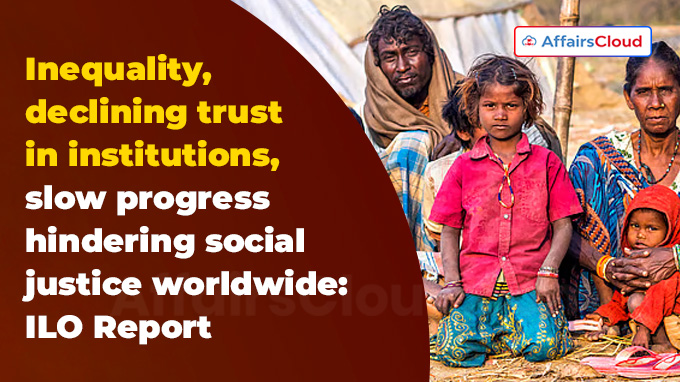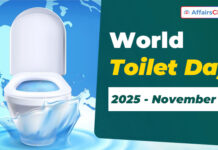In September 2025, the International Labour Organisation (ILO) released its latest report titled ‘The State of Social Justice 2025: A work in progress’, highlighted that the world is wealthier, healthier and better educated than in 1995, progress remains uneven, with inequality reduction stalling and benefits not equally shared.
- The report was released ahead of the 2nd World Summit for Social Development(WSSD) scheduled to be held in Doha, Qatar in November 2025.
Exam Hints:
- What? Release of ‘The State of Social Justice 2025: A work in progress’ Report
- Released by: ILO
- Key progress: decline in child labour rate (from 20.6% to 7.8%); extreme poverty (from 39% to 10%); working poverty (from 28% to 7%); work-related mortality rate (over 10%)
- People living in Poverty: 800 Million (globally)
- Time Period to Close Wage Gap: 50-100 years
- Poverty: 800M people still live on <USD 3/day
- Clean Water: 1 in 4 lacks safely managed drinking water
- Wealth/Income: Top 1% holds 20% of income, 38% of wealth
About State of Social Justice Report 2025:
Assessment: For the 1st time, ILO assessed the state of social justice in the world and reflects on the progress made over the last 30 years (since 1995).
Pillars: The report has outlined ILO’s vision for advancing social justice, based on 4 key pillars i.e. fundamental human rights and capabilities; equal access to opportunities; fair distribution and fair transitions.
Key Progress:
Child Labour: The report showed that Child labour among those aged between 5-14 years, has decreased from 250 million (1995) to 106 million (2024).
- Also, the rate of child labour has declined from 20.6% (in 1995) to 7.8% (in 2024).
- The report further revealed that 138 million children (aged 5-17years) in child labour, of which nearly 50% engaged in hazardous labour.
Poverty Rates: The report showed that extreme poverty rate decreased from 4 in 10 people (in 1995) to 1 in 10 (in 2023).
- It further showed that working poverty declined significantly to 6.9% (in 2024) compared to 27.9% (in 2000).
School Completion Rates: Since 2000, school completion rates in primary and secondary schools increased by 10% and 22%, respectively.
Social Protection Scheme: The report showed that for the 1st time, more than 50% of world’s population is now covered by some kind of social protection scheme, since 2023.
Work-Related Mortality: As per the report, work-related mortality has declined by over 10% since 2000.
Labour Productivity: The report revealed that labour productivity per worker surged by 78% worldwide; and by 215% in Upper-Middle-Income Countries (UMICs).
- Since 1995, labour productivity inequality between countries has decreased by 40%.
Persistent Deficits:
Poverty: The report showed that despite decrease in poverty rates, 800 million people still live on less than USD 3 per day.
Clean Water: As per the report, 1 in 4 people still lacks access to safely managed drinking water.
Wealth and Income: The report highlighted that top 1% of the world’s population holds 20% of income and 38% of wealth.
Labour Force: The report revealed that the labour force participation gap between men and women has decreased marginally by 3% points since 1995 and remains at 24%.
Wide Wage Gap: The report showed that wage gap between men and women stands at 78% in 2025.
- The report has projected with persistent current trends; 50 to 100 years will be taken to close the wage gap between men and women.
High Informality Rates: The report showed that the informality rate has decreased by just 2 percentage points since 2005, with 58% of worker still in informal employment.
- Based on income groups, Low-Income Countries (LIC) showed the highest informality rate i.e. 90%; followed by Lower Middle Income Countries (LMICs) (83%); UMICs (53%) and High-Income Countries (HICs) (8%).
Trust in Institutions: Public trust in governments, unions, and businesses has declined since 1982, attributed to perceptions of unfair reward systems and widening inequality.
Determination of Income based on Birth Country: As per the report, at least 71% of a person’s income is determined by the circumstances of their birth.
- At present, 55% of the difference in income of 8 billion in the world will depend on the country in which they are born.
Important Terms:
Extreme Poverty: It is defined using the global poverty line of USD 2.15 per day in 2017 Purchasing Power Parity (PPP).
Working Poverty Rate: It is the share of persons in employment living in extreme poverty as a share of total employment.
About International Labour Organisation (ILO):
Director-General (DG) – Gilbert F. Houngbo
Headquarters- Geneva, Switzerland
Member nations- 187
Established- 1919





